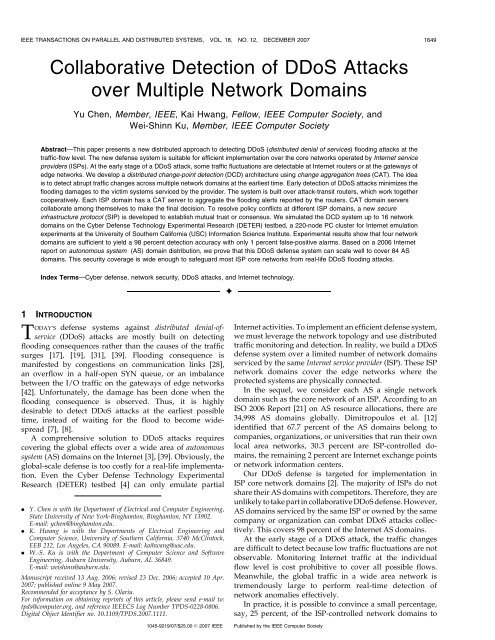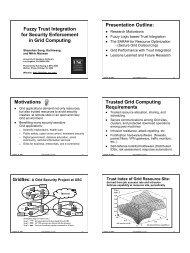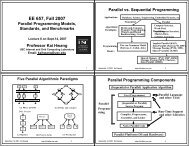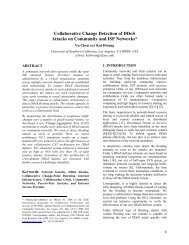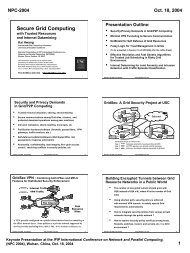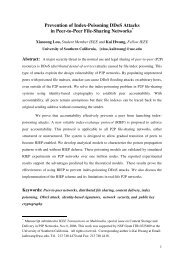Collaborative Detection of DDoS Attacks over Multiple Network ...
Collaborative Detection of DDoS Attacks over Multiple Network ...
Collaborative Detection of DDoS Attacks over Multiple Network ...
You also want an ePaper? Increase the reach of your titles
YUMPU automatically turns print PDFs into web optimized ePapers that Google loves.
IEEE TRANSACTIONS ON PARALLEL AND DISTRIBUTED SYSTEMS, VOL. 18, NO. 12, DECEMBER 2007 1649<strong>Collaborative</strong> <strong>Detection</strong> <strong>of</strong> <strong>DDoS</strong> <strong>Attacks</strong><strong>over</strong> <strong>Multiple</strong> <strong>Network</strong> DomainsYu Chen, Member, IEEE, Kai Hwang, Fellow, IEEE Computer Society, andWei-Shinn Ku, Member, IEEE Computer SocietyAbstract—This paper presents a new distributed approach to detecting <strong>DDoS</strong> (distributed denial <strong>of</strong> services) flooding attacks at thetraffic-flow level. The new defense system is suitable for efficient implementation <strong>over</strong> the core networks operated by Internet serviceproviders (ISPs). At the early stage <strong>of</strong> a <strong>DDoS</strong> attack, some traffic fluctuations are detectable at Internet routers or at the gateways <strong>of</strong>edge networks. We develop a distributed change-point detection (DCD) architecture using change aggregation trees (CAT). The ideais to detect abrupt traffic changes across multiple network domains at the earliest time. Early detection <strong>of</strong> <strong>DDoS</strong> attacks minimizes theflooding damages to the victim systems serviced by the provider. The system is built <strong>over</strong> attack-transit routers, which work togethercooperatively. Each ISP domain has a CAT server to aggregate the flooding alerts reported by the routers. CAT domain serverscollaborate among themselves to make the final decision. To resolve policy conflicts at different ISP domains, a new secureinfrastructure protocol (SIP) is developed to establish mutual trust or consensus. We simulated the DCD system up to 16 networkdomains on the Cyber Defense Technology Experimental Research (DETER) testbed, a 220-node PC cluster for Internet emulationexperiments at the University <strong>of</strong> Southern California (USC) Information Science Institute. Experimental results show that four networkdomains are sufficient to yield a 98 percent detection accuracy with only 1 percent false-positive alarms. Based on a 2006 Internetreport on autonomous system (AS) domain distribution, we prove that this <strong>DDoS</strong> defense system can scale well to c<strong>over</strong> 84 ASdomains. This security c<strong>over</strong>age is wide enough to safeguard most ISP core networks from real-life <strong>DDoS</strong> flooding attacks.Index Terms—Cyber defense, network security, <strong>DDoS</strong> attacks, and Internet technology.Ç1 INTRODUCTIONTODAY’S defense systems against distributed denial-<strong>of</strong>service(<strong>DDoS</strong>) attacks are mostly built on detectingflooding consequences rather than the causes <strong>of</strong> the trafficsurges [17], [19], [31], [39]. Flooding consequence ismanifested by congestions on communication links [28],an <strong>over</strong>flow in a half-open SYN queue, or an imbalancebetween the I/O traffic on the gateways <strong>of</strong> edge networks[42]. Unfortunately, the damage has been done when theflooding consequence is observed. Thus, it is highlydesirable to detect <strong>DDoS</strong> attacks at the earliest possibletime, instead <strong>of</strong> waiting for the flood to become widespread[7], [8].A comprehensive solution to <strong>DDoS</strong> attacks requiresc<strong>over</strong>ing the global effects <strong>over</strong> a wide area <strong>of</strong> autonomoussystem (AS) domains on the Internet [3], [39]. Obviously, theglobal-scale defense is too costly for a real-life implementation.Even the Cyber Defense Technology ExperimentalResearch (DETER) testbed [4] can only emulate partial. Y. Chen is with the Department <strong>of</strong> Electrical and Computer Engineering,State University <strong>of</strong> New York-Binghamton, Binghamton, NY 13902.E-mail: ychen@binghamton.edu.. K. Hwang is with the Departments <strong>of</strong> Electrical Engineering andComputer Science, University <strong>of</strong> Southern California, 3740 McClintock,EEB 212, Los Angeles, CA 90089. E-mail: kaihwang@usc.edu.. W.-S. Ku is with the Department <strong>of</strong> Computer Science and S<strong>of</strong>twareEngineering, Auburn University, Auburn, AL 36849.E-mail: weishinn@auburn.edu.Manuscript received 13 Aug. 2006; revised 23 Dec. 2006; accepted 10 Apr.2007; published online 9 May 2007.Recommended for acceptance by S. Olariu.For information on obtaining reprints <strong>of</strong> this article, please send e-mail to:tpds@computer.org, and reference IEEECS Log Number TPDS-0228-0806.Digital Object Identifier no. 10.1109/TPDS.2007.1111.Internet activities. To implement an efficient defense system,we must leverage the network topology and use distributedtraffic monitoring and detection. In reality, we build a <strong>DDoS</strong>defense system <strong>over</strong> a limited number <strong>of</strong> network domainsserviced by the same Internet service provider (ISP). These ISPnetwork domains c<strong>over</strong> the edge networks where theprotected systems are physically connected.In the sequel, we consider each AS a single networkdomain such as the core network <strong>of</strong> an ISP. According to anISO 2006 Report [21] on AS resource allocations, there are34,998 AS domains globally. Dimitropoulos et al. [12]identified that 67.7 percent <strong>of</strong> the AS domains belong tocompanies, organizations, or universities that run their ownlocal area networks, 30.3 percent are ISP-controlled domains,the remaining 2 percent are Internet exchange pointsor network information centers.Our <strong>DDoS</strong> defense is targeted for implementation inISP core network domains [2]. The majority <strong>of</strong> ISPs do notshare their AS domains with competitors. Therefore, they areunlikely to take part in collaborative <strong>DDoS</strong> defense. However,AS domains serviced by the same ISP or owned by the samecompany or organization can combat <strong>DDoS</strong> attacks collectively.This c<strong>over</strong>s 98 percent <strong>of</strong> the Internet AS domains.At the early stage <strong>of</strong> a <strong>DDoS</strong> attack, the traffic changesare difficult to detect because low traffic fluctuations are notobservable. Monitoring Internet traffic at the individualflow level is cost prohibitive to c<strong>over</strong> all possible flows.Meanwhile, the global traffic in a wide area network istremendously large to perform real-time detection <strong>of</strong>network anomalies effectively.In practice, it is possible to convince a small percentage,say, 25 percent, <strong>of</strong> the ISP-controlled network domains to1045-9219/07/$25.00 ß 2007 IEEE Published by the IEEE Computer Society
1650 IEEE TRANSACTIONS ON PARALLEL AND DISTRIBUTED SYSTEMS, VOL. 18, NO. 12, DECEMBER 2007TABLE 1Notations and Abbreviations Used in the Paperjoin in collective effort to combat <strong>DDoS</strong> attacks. Thisamounts a few hundreds <strong>of</strong> domains to form a consortiumin collective <strong>DDoS</strong> defense. We will prove in Section 5.1 thatit would be sufficient to involve only tens <strong>of</strong> domains towork together in coping with most <strong>DDoS</strong> flooding attacks.This defense range is certainly within the c<strong>over</strong>age <strong>of</strong> asingle ISP or <strong>of</strong> a few ISPs that collaborate with each other.To be cost-effective, we propose to monitor the traffic at asuperflow level. A superflow contains all packets destined forthe same network domain from all possible source InternetProtocol (IP) addresses and applies various protocols such asTransmission Control Protocol (TCP) or User DatagramProtocol (UDP), etc. This detection level c<strong>over</strong>s the aggregatefrom individual traffic flows. All packets <strong>of</strong> a superflow havethe same prefix IP address <strong>of</strong> the same destination domain[15]. Motivated by using lightweight detection with lowcomplexity [3], [9], [26], [42], we propose a distributed changepointdetection (DCD) architecture using a new mechanism,called change aggregation tree (CAT). The concept <strong>of</strong> CAT wasfirst presented in [11].This CAT mechanism is designed at the router level fordetecting abrupt changes in traffic flows. When a <strong>DDoS</strong> attackis launched, the routers observe changes in the spatiotemporaldistribution <strong>of</strong> traffic volumes. The domain server uses therouter-reported traffic surge reports to construct the CAT.Usually, these changes in traffic flows present a directionalityhoming toward the victim system. Random fluctuationsincurred with legitimate traffic flows do not present thehoming effects. For the benefit <strong>of</strong> our readers, Table 1summarizes the basic parameters and abbreviations used inthis paper.Our DCD approach is unique and <strong>of</strong>fers the very firstattempt to explore DCD <strong>over</strong> collaborative network domains.We detect the start <strong>of</strong> <strong>DDoS</strong> flooding attacks by monitoringabnormal traffic flows. This monitoring and detection isperformed from router to router as the CAT is dynamicallyconstructed on the fly. On the DETER testbed, we implementedthe detection scheme from 4 to 16 AS domains. We carriedout intensive experiments to evaluate the DCD scheme. Theperformance results demonstrate high detection accuracyand low false-positive alarms.The rest <strong>of</strong> this paper is organized as follows: Section 2briefly reviews related works. Section 3 presents the principle<strong>of</strong> the change-point detection method and the algorithms forraising attack alerts by individual routers. Section 4 explainsthe CAT construction within a single network domain. Theinterdomain change detection algorithm is presented inFig. 1. A traffic superflow by <strong>DDoS</strong> flooding attacks launched from alarge number <strong>of</strong> zombies toward a common victim host.Section 5, along with a new secure infrastructure protocol(SIP). Section 6 reports the DETER experiments setups andperformance results. Section 7 discusses scalability issues anddeployment limitations. Finally, we conclude with a summary<strong>of</strong> contributions and discuss further research neededtoward eventual use <strong>of</strong> the defense system in Section 8.2 RELATED WORK AND OUR CONTRIBUTIONS<strong>DDoS</strong> attacks <strong>of</strong>ten come with widespread worms [6]. Theattacker <strong>of</strong>ten exploits the huge resource asymmetry betweenthe Internet and the victim systems [39]. The flooding traffic islarge enough to crash the victim machine by communicationbuffer <strong>over</strong>flow, disk exhaustion, connection link saturation,and so forth. Fig. 1 shows a flooding attack launched fromfour zombies. The attack-transit routers (ATRs) detect theabnormal surge <strong>of</strong> traffic at their I/O ports. The victim isattached with the end router R0 in Fig. 1. All the attack flowsform the superflow homing toward the end router.A plethora <strong>of</strong> <strong>DDoS</strong> defense and response mechanismshave been suggested in the past, including IP traceback [1],[3], [17], packet filtering [26], and flood pushback [20]. Moresophisticated intrusion detection systems [19], [32] and<strong>DDoS</strong> defense schemes [10], [24], [31], [41] have beenrecently proposed. Researchers have attempted to combatrepeated <strong>DDoS</strong> attacks [18]. Others use <strong>over</strong>lay networks[43], <strong>DDoS</strong>-resilient scheduling [36], and trust-negotiation[37] approaches to establish trust.MUltiLevel Tree for Online Packet Statistics (MULTOPS)[16] and D-WARD [29] suggested filtering and rate limitingon suspicious flows at the source end. Security managers<strong>of</strong>ten focus on protecting their own networks and chooselocal detection approaches [7]. For instance, COSSACK [33]and DefCOM [29] deploy detectors at the victim side andsend an alert to the filter or to the rate limiter located at thesource side. Chen and Song [9] proposed a perimeter-basedscheme for ISP to enable anti-<strong>DDoS</strong> services to theircustomers. Their scheme relies on edge routers to identifythe sources <strong>of</strong> the flood <strong>of</strong> attack packets.Many researchers use the change-point detection theoryto detect abnormal Internet traffic caused by <strong>DDoS</strong> attacks[5], [11], [34], [42]. Lacking accurate statistics to describe theprechange and postchange traffic distributions, a nonparametriccumulative sum (CUSUM) scheme was developed
CHEN ET AL.: COLLABORATIVE DETECTION OF DDOS ATTACKS OVER MULTIPLE NETWORK DOMAINS 1651for its low computational complexity [5]. The schememonitors the short-term behavior shifting from a long-termbehavior. Once the cumulative difference reaches a certainthreshold, an attack alert is raised. Wang et al. [42]suggested a centralized <strong>DDoS</strong> defense scheme to monitorthe change points at the gateway level. Peng et al. [34] tooka similar approach in monitoring the source IP addresses.In this paper, we propose a new distributed aggregationscheme based on change-point detection across multiplenetwork domains. This scheme is extended from the singledomainchange-detection scheme reported in [11]. Weestablish cooperation among communicating networkdomains. This enables the building <strong>of</strong> an early warningsystem for <strong>DDoS</strong> defense across multiple ISP domains. OurDCD scheme is capable <strong>of</strong> tracing back automatically, oncethe detection is successfully carried out. The global CATdetects the network anomalies incurred on the fly.In summary, our contributions are highlighted below infour technical aspects, the details and pro<strong>of</strong>s <strong>of</strong> which aregiven in subsequent sections:1. Traffic anomaly detection at the superflow level. MonitoringInternet traffic at routers on individual flows isidentified by a 5-tuple: {source IP, destination IP, sourceport, destination port, protocol applied}. The superflowconsists <strong>of</strong> those traffic flows destined for the samenetwork domain and applied the same protocol. Thislevel <strong>of</strong> traffic monitoring and anomaly detection ismore cost-effective for <strong>DDoS</strong> defense in real-lifeInternet environments.2. Distributed change-point detection. Considering thedirectionality and homing effects <strong>of</strong> a <strong>DDoS</strong> floodingattack, we propose to use collaborative routers forDCD and use the domain servers for alert correlationand aggregation.3. Hierarchical alerts and detection decision making. Oursystem adopts a hierarchical architecture at the routerand domain levels. This simplifies the alert correlationand global detection procedures and enables theDCD system implementation in ISP networks.4. Novelty <strong>of</strong> SIP. We propose a new trust-negotiatingSIP to secure interserver communications. The SIPhas removed some <strong>of</strong> the shortcomings <strong>of</strong> theexisting IP security (IPsec) and application-layermulticasting protocols [25], [43]. SIP appeals forimplementation on virtual private network (VPN)tunnels or <strong>over</strong> an <strong>over</strong>lay network built on top <strong>of</strong> alldomain servers.3 DISTRIBUTED CHANGE-POINT DETECTIONThe DCD scheme detects <strong>DDoS</strong> flooding attacks bymonitoring the propagation patterns <strong>of</strong> abrupt trafficchanges at distributed network points. Once a sufficientlylarge CAT is constructed to exceed a preset threshold, anattack is declared. This section presents the principlesbehind the DCD system. We focus on traffic pattern changedetection at the router level.Fig. 2. Distributed change detection <strong>of</strong> <strong>DDoS</strong> attacks <strong>over</strong> multipleAS domains. (a) Multidomain <strong>DDoS</strong> defense system. (b) Interdomaincommunication via VPN tunnels or an <strong>over</strong>lay network atop theCAT servers in four domains.3.1 The DCD System ArchitectureFig. 2 presents the system architecture <strong>of</strong> the DCD scheme.The system is deployed <strong>over</strong> multiple AS domains. There is acentral CAT server in each domain. The system detects trafficchanges, checks flow propagation patterns, aggregatessuspicious alerts, and merges CAT subtrees from collaborativeservers into a global CAT. The root <strong>of</strong> the global CAT is atthe victim end. Each tree node corresponds to an ATR. Eachtree edge corresponds to a link between the ATRs.Our system has a hierarchical detection architecture.There are three layers in this architecture. At the lowestlayer, an individual router functions as a sensor tomonitor local traffic fluctuations. A change-point detectionprogram (Algorithm 1) is executed on each router.Considering the directionality and homing effects in a<strong>DDoS</strong> flooding attack, routers check how the wavefrontchanges. A router raises an alert and reports ananomalous traffic pattern to the CAT server.The second layer is at each network domain level. TheCAT server constructs a CAT subtree according to the alertscollected. The subtree displays a spatiotemporal vision <strong>of</strong>the attack superflow in the domain. At the highest layer, theCAT servers at different domains form an <strong>over</strong>lay network.For security precaution, they communicate with each otherthrough VPN channels.All CAT servers send their locally generated CATsubtrees to the edge server in the destination domain
1652 IEEE TRANSACTIONS ON PARALLEL AND DISTRIBUTED SYSTEMS, VOL. 18, NO. 12, DECEMBER 2007estimate <strong>of</strong> the average number <strong>of</strong> packets is definediteratively byXðt m ;iÞ¼ð1 Þ Xðt m 1 ;iÞþ xðt m ;iÞ; ð1Þwhere 0
1654 IEEE TRANSACTIONS ON PARALLEL AND DISTRIBUTED SYSTEMS, VOL. 18, NO. 12, DECEMBER 2007TABLE 2Alert Message Reported by a Routerinformation, the domain server constructs the CAT graduallyafter receiving the alert reports from the ATRs.Table 2 summarizes the information carried in a typicalalert message from an ATR. The output <strong>of</strong> Algorithm 2 is asingle-domain CAT subtree similar to the one shown inFig. 3. The CAT is specified by a hierarchical data structure.The root node carries the superflow ID, the number <strong>of</strong>routers involved, root node ID, and the count <strong>of</strong> child nodesat the next level.Algorithm 2: CAT Subtree Construction in a SingleDomain ServerInput: Traffic alert messages received from all routers in thesame AS domainOutput: A data structure describing the CAT subtreeconstructed in this domainProcedure:01: Read all suspicious patterns in and arrange themaccording to router ID02: Start from the suspicious node with minimum ID R min03: root R min04: read the upstream node number up_num05: read the downstream node number dn_num06: node number node number þ up num 107: While up_num > 008: Read in one upstream node R up09: Add R up as a leaf node10: scan through its upstream nodes11: up num up num 112: End While13: While dn num ¼ 114: Read the downstream node R dn ;15: root R dn16: node number node number þ 117: Scan through other upstream nodes <strong>of</strong> new root;18: dn_num dn_num <strong>of</strong> the new root19: End WhileTo clarify the control flow, this construction process isspecified by a flowchart in Fig. 5. The next level lists the pair<strong>of</strong> information {L1 node ID, count <strong>of</strong> children at next levelL2}. This process continues until it reaches the leaf nodes <strong>of</strong>the tree. The CAT subtree is sent to the CAT server <strong>of</strong> thedestination domain. In Algorithm 2, the domain serverconstructs the CAT subtree based on collected status reportsfrom the routers. Routers that detected no attacks are notinvolved in the tree construction.Starting from the node R min with a minimum ID in Fig. 5,the CAT server takes it as the root node. The server scansFig. 5. Control flow in Algorithm 2 to construct a CAT subtree.through upstream child nodes identified by up_id. Thisdescendent search is performed iteratively until the leafnodes are reached. If there is a downstream router R dn ,wetake router R dn as the new root and repeat the procedure.Meanwhile, the descendent search procedure is repeatedfor all upstream routers <strong>of</strong> root R dn . Then, we check thedownstream router <strong>of</strong> R dn and repeat the procedure untilthe downstream router is out <strong>of</strong> the domain boundary.5 MERGING TRAFFIC IN MULTIPLE DOMAINSThis section describes the extension <strong>of</strong> the single-domaindetection scheme to work on multiple network domains.First, we analyze the complexity <strong>of</strong> the global CAT growth inreal-life Internet domains. Then, we present the mechanismsfor cross-domain attack detection. In addition, we introduce anew protocol that supports interdomain communications,trust negotiation, and collaborative detection.5.1 CAT Growth with Domain DistributionThe complexity <strong>of</strong> the CAT growth is analyzed below basedon Internet topology data available from open literature[21], [38]. Fig. 6 illustrates the process <strong>of</strong> the CAT growthout <strong>of</strong> merging subtrees from attack-transit domains. Let rbe the number <strong>of</strong> hops from an AS domain to thedestination domain. The server checks the received subtreesin increasing order <strong>of</strong> distance r.The system first merges the subtrees from ASs located in1-hop ðr ¼ 1Þ distance to form a partial global tree. Next, itmerges the subtrees from domains at 2-hop distance. Themerging process repeats with distances r ¼ 3, 4 until all
CHEN ET AL.: COLLABORATIVE DETECTION OF DDOS ATTACKS OVER MULTIPLE NETWORK DOMAINS 1655Fig. 6. Merging CAT subtrees from neighboring AS domains to outerdomains to build a global CAT, where AS 0 is the victim domain, andr max ¼ 6 hops.subtrees are merged into the final global CAT. We analyzebelow the complexity <strong>of</strong> global CAT growth at intradomainand interdomain levels. The routers monitor traffic conditionsand report anomalies to their domain CAT serverperiodically. The local setting parameters and affect thesize <strong>of</strong> the local CAT subtrees constructed.Given a domain consisting <strong>of</strong> N routers, the number <strong>of</strong>alerts that the CAT server receives is proportional to N. Thethreshold used in CAT subtree construction (Algorithm 2) isequal to the number <strong>of</strong> alerts received by the final CATserver. Therefore, the detection time is estimated by OðNÞwithin each domain. Of course, different domain sizes ðNÞmay require a variable subtree generation time.At the interdomain level, the complexity <strong>of</strong> global CATmerging is highly dependent on the network topology. Wemodel the Internet domains as an undirected graph <strong>of</strong>M nodes and E edges. The diameter <strong>of</strong> the graph is denotedby .Siganos et al. [38] model the Internet neighborhood as anH-dimensional sphere with a diameter . The parameter H isthe dimension <strong>of</strong> the network topology [14]. For example,H ¼ 1 specifies a ring topology, and H ¼ 2, a 2-dimensionalmesh. Any two nodes are within an effective diameter, ef hops away from each other. Faloutsos et al. estimatedthe magnitude <strong>of</strong> ef by the following expression:M 2 1=H ef ¼: ð7ÞM þ 2EIn 2002, the dimension <strong>of</strong> the Internet was calculated asH ¼ 5:7 in an average sense. The ceiling <strong>of</strong> this diameter efis thus set to be 6. Let NNðhÞ be the number <strong>of</strong> domainslocated at distance h from a typical domain in the Internet.Table 3 gives the domain distribution—the probability <strong>of</strong> anAS domain residing exactly h hops away from a referencedomain. The numbers <strong>of</strong> domains in various distanceranges are given in the second row. It is interesting to notethat most communicating domains are within 3 or 4 hops,almost following a normal distribution centered on anaverage hop count <strong>of</strong> 3.5.The number <strong>of</strong> Internet AS domains keeps increasing intime, the Faloutsos et al. reports [14], [38] indicates that thisAS distribution is pretty stable <strong>over</strong> time. This implies that apacket can reach almost all domains in the Internet bytraversing through 6 hops. Therefore, we set the maximumhop count r max ¼ 6 in Fig. 6.Let p h be the probability <strong>of</strong> having an AS domain locatedat distance h from the reference domain Therefore, theaverage number <strong>of</strong> domains used to build a global CAT isupper bounded byT ¼ Xr maxNNðhÞp h :h¼1Substituting the entries in Table 2 into (9), we obtain theexpected domain countT ¼ 14 0:004 þ 2818 0:0805 þ 13493 0:3855 þ 13342 0:3812 þ 4445 0:127 þ 788 0:0225 þ 102 0:0029¼ 11; 097domains used in average Internet applications. This domaincount posts a loose upper bound on the expected number <strong>of</strong>ISP domains involved in building a global CAT.In reality, only a few ISP-controlled AS domains maycommit to defend <strong>DDoS</strong> attacks collaboratively. On theconservative side, consider that 5 percent <strong>of</strong> ISP AS domainsare committed. Thus, the above upper bound could bereduced to only 168 ISP domains, provided that they conformto the domain distribution in Table 3.5.2 Global Tree Construction at the Victim EndIn a <strong>DDoS</strong> flooding attack, the attacker <strong>of</strong>ten recruits manyzombies distributed <strong>over</strong> the Internet. The flooding trafficmay travel through multiple AS domains before reaching theedge network where the victim is physically attached.Routers at the upstream domains observe the suspicioustraffic flows earlier than routers at the downstream networks.Our DCD system was designed to have strong collaborationsamong all domain servers along the superflow paths.Algorithm 3 specifies the merge <strong>of</strong> CAT subtrees fordetecting <strong>DDoS</strong> attacks across multiple network domains.The CAT subtrees constructed at all traversed domainsmust be merged to yield a global CAT at the destinationdomain.Algorithm 3: Global CAT Construction and <strong>Detection</strong>DecisionInput: CAT subtree reports from participating domainservers, the server detection threshold .ð8ÞTABLE 3Internet Domain Distribution Reported on 28 February 2006 [21]
1656 IEEE TRANSACTIONS ON PARALLEL AND DISTRIBUTED SYSTEMS, VOL. 18, NO. 12, DECEMBER 2007Output: The global CAT <strong>over</strong> multiple AS domains. Raisethe alert for an imminent <strong>DDoS</strong> attack.Procedure:01: Construct the local CAT subtree (Algorithm 2)periodically02: Receiving subtrees from other CAT servers03: If local subtree exists, Then Check the superflow ID,04: If this domain is the destination domain, Then Setdistance r ¼ 105: Merge subtrees from domains at distance r to thecurrent global tree06: r r þ 107: While {there are unchecked subtrees}, generate theCAT pr<strong>of</strong>ile08: If CAT pr<strong>of</strong>ile Then <strong>DDoS</strong> attack is detectedand raise an alert09: Else Check the root router position10: If root router is connected to other domain11: Then Sent the global CAT to the destinationdomain server12: Else Raise an attack alert based on the global treemergedThe final declaration <strong>of</strong> a <strong>DDoS</strong> attack is the result <strong>of</strong>threshold detection using the global CAT. Not only thevictim network launches appropriate countermeasures, butalso some traceback actions are to be taken by all ATRsalong the superflow paths. The actions include dropping <strong>of</strong>suspicious packets or rate limiting against the flows.The global CAT corresponds to the flooding attack flows.The leaf nodes are directly related to the zombies used. Theheight <strong>of</strong> the global CAT corresponds to the superflow hopcount. Some highly distributed attacks may recruit hundreds<strong>of</strong> zombies; the global CAT may c<strong>over</strong> a wide area onthe Internet. Therefore, we use the global CAT pr<strong>of</strong>ile as aglobal detection threshold. The CAT pr<strong>of</strong>ile indicates howmany routers observed abnormal traffic surges. Thus, isan integer bounded by the number <strong>of</strong> ATRs in a domain.The tree width and height thus reveal the scope <strong>of</strong> the<strong>DDoS</strong> attack. Through experiments on the DETER testbed,we obtain the global detection threshold value by trainingfrom some attack data sets. These threshold values haveyielded the highest detection rate and lowest false-positiverate during the training period.Upon receiving subtrees from upstream CAT servers, theCAT server in the destination domain builds the globalCAT from its local subtree. Once the global CAT is formed,the server compares the CAT pr<strong>of</strong>ile with the globaldetection threshold to decide on a <strong>DDoS</strong> attack. An alertis raised, and a necessary countermeasure is triggeredaccordingly. Fig. 7 shows an example network environmentinvolving six AS domains. The victim system is located inthe AS1 domain. Zombies are scattered widely in theInternet outside the illustrated domains. By detectingabnormal traffic changes in each domain, the CAT servercreates a CAT subtree locally at each domain usingAlgorithm 2.Fig. 7b shows the three steps taken to merge the sixsubtrees generated by the six CAT servers <strong>of</strong> the sixAS domains. All six subtrees resulted from checking theFig. 7. An example six-domain global CAT construction environment.(a) DCD system architecture <strong>over</strong> six domains. (b) Merging six CATsubtrees to yield a global CAT.packets belonging to the same superflow traffic destined forthe same domain AS1. Five subtrees generated in AS2, AS3,AS4, AS5, and AS6 at upstream domains are sent to AS1 atStep 2. Then, the concatenated CAT subtrees are connectedto the downstream subtree in AS1. Thus, the global CAT isfinally rooted at the last hop router to an edge network R0that is attached to the victim system.5.3 Secure Infrastructure Protocol (SIP)To support global CAT construction across multipledomains, we propose a new SIP by extending from theInternet Control Message Protocol (ICMP) [35]. The SIP isdesigned as an integral part <strong>of</strong> the IPv4 standard in a layercloser to the physical network. To provide a secure
CHEN ET AL.: COLLABORATIVE DETECTION OF DDOS ATTACKS OVER MULTIPLE NETWORK DOMAINS 1657Fig. 8. Three communication levels in using the SIP between two CATservers in two AS domains.information exchange platform, the protocol supports threelevels <strong>of</strong> communication as illustrated in Fig. 8.The lowest level enables routers in the same domain toshare information in status monitoring. The second levelsupports communication between routers and theCAT server in each domain. Routers periodically reportlocal traffic detection results to the domain server. Thehighest level supports interdomain communication amongthe CAT servers in trust negotiation to resolve conflicts insecurity polices in different domains.Due to privacy and security concerns, ISPs are reluctant toreveal inside information to competitors, such as topology,bandwidth configuration, and capabilities. Hence, aside frommanaging the information exchange, servers are also incharge <strong>of</strong> trust negotiation. We adopted the trust negotiation<strong>of</strong> multilateral security suggested by Ryutov et al. [37].Using their Generic Authorization and Access-control (GAA)interface, SIP can help establish trust among AS domains andenter a collaborative <strong>DDoS</strong> defense system agreement. Bytrust negotiating, ISPs can determine how much privateinformation is allowed to be shared with others.When a domain server enters a collaborative defenseagreement with another domain server, the administratorsets up the trust levels required. Each server needs toperform a trust negotiation with a peer server only oncewith each new domain joining. The trust level determineshow much sensitive information can be disclosed whenexchanging detected anomalies information.SIP is designed with three trust levels: full trust (FT), basictrust (BT), and no trust (NT). With FT, the SIP server willprovide all necessary information that describes the characteristics<strong>of</strong> the detected anomaly. With BT, the SIP serveronly sends some statistics containing no private andsensitive data. When NT is set, no cooperation takes placebetween the CAT servers.Existing security protocols like IPsec and ICMP focus oninformation security through strong cryptography to avoideavesdropping, strict access control to block illegal access,the use <strong>of</strong> digital signatures, and so forth. ICMP is used tocontrol error, when a network device or host requiresreporting an error in datagram processing [35].In contrast, SIP is designed to monitor the status <strong>of</strong> thenetwork infrastructure such as link bandwidth utility,fluctuation <strong>of</strong> traffic, and so forth. Although both IPsecand SIP are implemented at the IP layer, SIP is totallydeployed inside the intermediate network and does notneed support from the end hosts.Fig. 9. Multi-PC cluster architecture <strong>of</strong> the DETER Testbed at USC/ISI.6 RESULTS FROM DETER EXPERIMENTSWe verify the performance <strong>of</strong> the newly proposed<strong>DDoS</strong> detection scheme with network attack experimentson a 220-node DETER testbed [4] at the University <strong>of</strong>Southern California Information Sciences Institute (USC/ISI). The experimental settings and performance resultsare reported below.6.1 Settings on DETER TestbedTo evaluate the performance <strong>of</strong> the CAT-based <strong>DDoS</strong>detection system, we performed experiments using variantnetwork topology, background traffic, and attack generation.We adopt real-world ISP topologies downloaded fromthe Rocketfuel Project at the University <strong>of</strong> Washington [2].The DETER testbed is essentially an Internet emulator built<strong>over</strong> a cluster <strong>of</strong> PCs to perform a broad range <strong>of</strong> networksecurity experiments.We report below the DETER results on 2, 4, 8, and16 collaborative domains. Each domain typically has 7 to12 routers. Fig. 9 shows the DETER cluster configurationbuilt at USC/ISI. Due to limited 220 nodes in DETER, wechoose the smallest ISP configuration topology from theRocketfuel data set.In the DETER testbed experiments, 34 routers weresimulated <strong>over</strong> four AS domains. The link bandwidthamong the network domains was set at 100 Mbytes/s. Togenerate the background traffic closer to reality, we use theOC48 trace data set from the Cooperative Association forInternet Data Analysis (CAIDA) project [30] to regenerateInternet traces using the Harpoon traffic generator [40]. Togenerate <strong>DDoS</strong> attacks, we use the toolkit Stacheldraht(version 4.0) [13]. Stacheldraht generates the ICMP, UDP,TCP SYN flooding, and Smurf attacks.6.2 Performance Metrics UsedThe performance <strong>of</strong> our DCD detection scheme is evaluatedwith three metrics: detection rate, false-positive alarms, andsystem <strong>over</strong>head. All the metrics are measured under different<strong>DDoS</strong> attacks using TCP, UDP, and ICMP. The detection rateR d <strong>of</strong> <strong>DDoS</strong> attacks is defined by the following ratio:R d ¼ a=n;ð9Þ
1658 IEEE TRANSACTIONS ON PARALLEL AND DISTRIBUTED SYSTEMS, VOL. 18, NO. 12, DECEMBER 2007Fig. 10. Total alerts plotted against the router threshold in DETERexperiments with 34 routers in four AS domains using a 500 msmonitoring window.where a is the number <strong>of</strong> <strong>DDoS</strong> attacks detected in thesimulation experiments, and n is the total number <strong>of</strong> attacksgenerated by the Stacheldraht toolkit during the experiments.In addition, we are interested in the performance <strong>of</strong> ourDCD scheme under normal traffic without <strong>DDoS</strong> attacks. Atraffic superflow is called a false-positive alarm if an attack isdetected out <strong>of</strong> the normal traffic without attacks. Let p be thenumber <strong>of</strong> false-positive alarms raised by the CAT server andm be the total number <strong>of</strong> normal traffic flow events checkedby the simulator. Therefore, the ratio p=m defines the falsepositivealarm rate:R fp ¼ p=m:ð10ÞThe receiver operating characteristic (ROC) curve showsthe trade-<strong>of</strong>f between the detection rate and the falsepositiverate. Section 6.4 reports the detection accuracymeasured under different detection thresholds. Anothercritical issue is the time <strong>over</strong>head to detect the launch <strong>of</strong><strong>DDoS</strong> attacks. The average detection time measures fromthe start <strong>of</strong> a <strong>DDoS</strong> attack to the time <strong>of</strong> raising an alarm.The monitoring window should be chosen to be greaterthan this detection time.6.3 DETER Experimental ResultsTo evaluate the effectiveness <strong>of</strong> the DCD detection scheme,we report the alerts raised at the routers and analyze theCAT subtree properties. The DETER experiments choosethe inertia factor in the range (0.1, 0.5) and the routerdetection threshold in the range (2, 5).6.3.1 Alert Magnitude and Router ThresholdWe used 34 routers in four AS domains in the DETERtestbed. When the traffic flow exceeds the router threshold, the router raises alerts. No alert will be raised if noanomaly is detected at the routers. Fig. 10 illustrates thetotal numbers <strong>of</strong> alerts raised by the routers with SYNflooding compared with the case <strong>of</strong> no attack. More alertsare raised with attacks compared with alerts from no attack.The two left bars <strong>of</strong> each group correspond to ¼ 0:1,the case <strong>of</strong> heavy dependence on the past average traffic toraise an alert. The leftmost bar stays at around 20 alerts,Fig. 11. Variations <strong>of</strong> the global CAT size <strong>over</strong> four AS domains in a500 ms monitoring window.which is insensitive to increasing threshold . The second(gray) bar reduces to five alerts as increases. This impliesthat ¼ 3:5 is an ideal threshold to distinguish attacks fromno attack. The two right bars (fabric and black) demonstratea higher inertia value setting ¼ 0:3. The fabric bars withattacks are much higher than the black bars without attacks.For 0:3 and 3:5, the alert bars reduce to zero,meaning that the attack is not detectable.6.3.2 The Global CAT Pr<strong>of</strong>ilesFig. 11 displays the global CAT pr<strong>of</strong>ile, defined by thetree size or the number <strong>of</strong> routers that have raised thealert signals. We plot the tree pr<strong>of</strong>ile against the routerdetection threshold . For a small traffic inertia ¼ 0:1,the SYN flood has an average <strong>of</strong> 20 routers being alertedto yield the CAT subtree. Without attacks, this tree pr<strong>of</strong>ilereduces to less than five nodes.With a higher traffic inertia ¼ 0:3, the SYN attackresults in a tree pr<strong>of</strong>ile with around 10 alerts. Withoutattacks, the alert pr<strong>of</strong>ile reduces to zero after the threshold exceeds 3. Based on these results, we disc<strong>over</strong> an optimalrouter threshold setting 3:5 with an inertia ratio ¼ 0:1.When 20 out <strong>of</strong> 34 routers launched alerts, the routerutilization is 20=34 ¼ 58 percent.6.3.3 Effects <strong>of</strong> the Monitoring Window SizeThe size <strong>of</strong> the monitoring window affects the number <strong>of</strong>alerts raised in multiple AS domains. Through experimentson the DETER testbed, we observed the optimal monitoringwindow size to be 100 ms. The false-positive alarm numberincreases steadily with the increase in the monitoringwindow size. However, the number <strong>of</strong> alerts with realSYN attacks remains the same for all monitoring windowsizes, as shown in Fig. 12.In Stacheldraht [13], the UDP and ICMP packet rate foreach zombie is adjustable through setting different UDP andICMP packet sizes—the longer the packet length, the lowerthe packet rate. The TCP SYN attacks use a fixed packet size <strong>of</strong>64 bytes with a fixed packet rate. The maximum UDP andICMP packet size is limited to 1,024 bytes in Stacheldraht. Weobserved a similar detection rate for TCP SYN and UDP/ICMP attacks with 128-byte packets.
CHEN ET AL.: COLLABORATIVE DETECTION OF DDOS ATTACKS OVER MULTIPLE NETWORK DOMAINS 1659Fig. 12. The router alert number with and without <strong>DDoS</strong> attacksmonitored using various window sizes.6.4 <strong>Detection</strong> Accuracy and False AlarmsIn this section, we report the detection accuracy <strong>of</strong> theDCD scheme under TCP SYN, UDP, and ICMP attackswith different packet rates. The reported results correspondto ¼ 0:1, ¼ 2:0, and w ¼ 500 ms. The detectionaccuracy is reflected by two factors—the detection rateand the false-positive rate. In order to achieve highdetection accuracy, we have to increase the detection rateand decrease the false-positive rate. However, a trade-<strong>of</strong>fexists between the two factors as discussed in thefollowing paragraphs.6.4.1 <strong>Detection</strong> Rate <strong>of</strong> <strong>DDoS</strong> <strong>Attacks</strong>Fig. 13 illustrates the variances <strong>of</strong> the detection rate (7) withrespect to different server detection thresholds ðÞ. TheTCP SYN attack has the highest detection rate, which is closeto 100 percent with 12. The low-rate UDP attacks have alower detection rate than TCP attacks.For UDP attacks <strong>of</strong> 512-byte packets, the detection rate canbe kept above 80 percent with 9. When the packet sizeincreases to 1,024 bytes, the detection rate drops to zero with 7. These results demonstrates that in order to maintain ahigh detection rate on TCP and UDP SYN attacks, we need toFig. 14. Effects <strong>of</strong> the threshold on the false-positive rate in detectingTCP SYN attacks.set to a small value such as ¼ 5 and adjust the packet sizeto 1,024 bytes.6.4.2 False-Positive AlarmsFig. 14 shows the false-positive alarm rate against the CATserver threshold . The number <strong>of</strong> alert generated byrandom fluctuation in normal traffic is small and negligible.With a server detection threshold ¼ 4, the false-positiverate drops to less than 1 percent. However, the realchallenge lies in the fact that highly distributed attacksmay use low packet rates to avoid being detected [39]. Onlyafter sufficient attack flows are merged is the deviationdetected by the routers. Hence, a small detection thresholdvalue is required to achieve high detection accuracy with alow false-positive rate.The ROC curve in Fig. 15 explains the trade-<strong>of</strong>f betweenthe detection rate and false-positive rate under variousattacks. Our detection scheme achieves a detection rate ashigh as 99 percent with less than 1 percent false-positiverate for high-rate <strong>DDoS</strong> attacks. All three curves supportthis observation. Even for low-rate UDP attacks, our choice<strong>of</strong> a low CAT threshold ðÞ accomplishes a detection rate <strong>of</strong>91 percent at a false-positive rate <strong>of</strong> 23 percent. This resultproves the effectiveness <strong>of</strong> the DCD detection mechanismFig. 13. Effects <strong>of</strong> the server threshold on the detection rate <strong>of</strong> three<strong>DDoS</strong> attack types.Fig. 15. ROC curves showing the trade-<strong>of</strong>f between the detection rateand false-positive rate <strong>of</strong> <strong>DDoS</strong> attacks.
1660 IEEE TRANSACTIONS ON PARALLEL AND DISTRIBUTED SYSTEMS, VOL. 18, NO. 12, DECEMBER 2007This number is manageable, considering that the addedmonitoring burden <strong>of</strong> routers and the role <strong>of</strong> the CAT serverin each AS domain. In reality, the decision process is endedmuch earlier by using a lower threshold . This leads to theconclusion that the DCD system scales well to c<strong>over</strong> a widerarea <strong>of</strong> flooding <strong>DDoS</strong> attacks.Fig. 16. Scalability in using the DCD defense system for <strong>DDoS</strong> defense,where four AS domains are sufficient to yield a 68-98 percent detectionrate based on DETER simulation results.7 SCALABILITY AND DEPLOYMENT LIMITATIONSTo deploy a distributed security scheme in ISP corenetworks, the scalability is related to the network size,domain number, data rate, link capacity, or router numberinvolved. This section studies the scalability <strong>of</strong> the DCDscheme in terms <strong>of</strong> detection performance and the system<strong>over</strong>head experienced. Then, we discuss the issues <strong>of</strong> flashcrowd, security holes, and implementation limitations <strong>of</strong>the DCD system.7.1 Domain Scalability in ISP C<strong>over</strong>ageThe study <strong>of</strong> domain scalability is driven by reducing thecosts in system implementation and maintenance. Oneadvantage <strong>of</strong> collaborative detection is its enlarged area <strong>of</strong>protection c<strong>over</strong>age. We have to use the CAT subtreesconstructed by upstream domains to assess the earlierimpact <strong>of</strong> a superflow generated by a <strong>DDoS</strong> attack. Evenbefore the target network is <strong>over</strong>whelmed, an early warningcan prevent catastrophic disasters.Fig. 16 plots the detection rates <strong>of</strong> three <strong>DDoS</strong> attack typesagainst the number <strong>of</strong> domains used. Through experimentson the DETER testbed, we studied the effectiveness <strong>of</strong> crossdomaincooperation up to 16 AS domains. The detection ratebecomes saturated after a sufficient number <strong>of</strong> AS domainsare involved. The results are obtained under the systemsettings ¼ 0:1, ¼ 2:0, w ¼ 500 ms, and ¼ 5.Recall that we simulated 8 to 10 routers per domain inscalable DETER experiments. With a small AS domaincontaining eight routers, ¼ 5 implies that more than half<strong>of</strong> the routers generated alerts as the attack flowsapproaches the root <strong>of</strong> the CAT. For 64-byte attacks, theoptimal domain size is 4. For UDP 512-byte packets, thedetection rate saturates at eight domains. For UDP 1,024-byte packets, four AS domains are sufficient to achievethe saturated detection rate.The above analysis implies that 25 percent (4 out <strong>of</strong> 16) to50 percent (8 out <strong>of</strong> 16) <strong>of</strong> participating network domainswould be sufficient to detect a <strong>DDoS</strong> attack. Based on thislevel <strong>of</strong> domain participation, we find in Table 3 that theDCD system can scale well to c<strong>over</strong> T 30:3 percent 5 percent ð25 to 50 percentÞ ¼42 to 84 domains in commercialISP core networks. This result is rather encouragingin practical applications.7.2 Implementation and LimitationsIt is a big challenge to discriminate <strong>DDoS</strong> attacks from thefluctuation <strong>of</strong> legitimate traffic patterns, called shrew attacks[10] and flash crowds [23]. When a flash crowd happens, theCAT server creates a similar tree and could raise a falsealarm. We suggest adding a few new features to separatethe real <strong>DDoS</strong> attack traffic from the flash crowd.The idea is to check newly appeared source IP addresses.For each superflow, in addition to traffic volume, we need tomonitor the distribution <strong>of</strong> source IP addresses. Packetcontent matching <strong>of</strong>fers another potential solution. However,this option is limited by the packet payload being encrypted.Compromised insiders are <strong>of</strong>ten the most difficultproblem to solve in security control. Infected routers mayhide suspicious traffic patterns or send false alarms to theCAT server. These false alarms can weaken the use <strong>of</strong> theCAT as a means <strong>of</strong> attack detection.We can make the DCD system more robust by introducinga topology verification procedure. Knowing the networktopology, the CAT server is capable <strong>of</strong> rectifying thefalsely reported traffic patterns according to the upstreamand downstream relationship. A single or limited number<strong>of</strong> Byzantine defectors could be blocked this way.The CAT server in the destination domain merges allreceived CAT subtrees to make a global detection. The globalCAT provides useful information for traceback or pushback.In the literature, packet marking <strong>of</strong>fers another option to tracethe path <strong>of</strong> attackflows [1],[20]. The victim launches tracebackor pushback operations only after a <strong>DDoS</strong> attack is fullydetected. In contrast, our DCP system finishes the tracebacktask as soon as the merged CAT becomes sufficiently large.Our system pushes the defense line to upstream domains,where the traffic surges are first observed.Internet AS resource distribution [21] suggests the use <strong>of</strong>up to 84 domains to cope with TCP SYN and UDP floodingattacks. This corresponds to a saturated detection rate(98 percent) and low false-alarm rate (below 1 percent). Ifwe lower to a 65 percent detection rate with 15 percent falsealarms, the server detection threshold ðÞ can be furtherlowered. This implies that fewer AS domains could be usedto make a decision. Based on our DETER experiments, it issufficient to involve only 28 ISP domains in detecting most<strong>of</strong> the known <strong>DDoS</strong> flooding attacks.8 CONCLUSIONS AND FURTHER RESEARCHIt is crucial to detect the <strong>DDoS</strong> flooding attacks at their earlylaunching stage before widespread damage is done tolegitimate applications on the victim system. We develop a<strong>DDoS</strong> detection system based on a new CAT mechanism. Inconclusion, we elaborate on potential impacts and applications<strong>of</strong> the system:1. Detecting traffic changes at ATRs. Based on the anomalypattern detected in related network domains, ourscheme detects a <strong>DDoS</strong> attack before the victim is<strong>over</strong>whelmed. This approach captures the abrupttraffic changes at ATRs. The high detection rate <strong>of</strong>
CHEN ET AL.: COLLABORATIVE DETECTION OF DDOS ATTACKS OVER MULTIPLE NETWORK DOMAINS 1661<strong>DDoS</strong> attacks is expected with very low false-positivealarms.2. Scalable performance <strong>over</strong> multiple ISP domains. OurDCD detection scheme is suitable for deployment atthe ISP core networks. The provider-level cooperationeliminates the need for intervention by edge networks.Our DETER experimental results prove that four toeight domains are sufficient to yield a 98 percentdetection rate <strong>of</strong> TCP SYN and UDP flooding attacks.Based on a recently reported Internet AS domaindistribution, we expect the defense scheme to scalewell to c<strong>over</strong> up to 84 ISP-controlled domains in a reallifeInternet environment.3. SIP for interdomain trust negotiation. To support inter-AS collaboration, SIP is proposed to resolve policyconflicts and regulate the alert message format. OurSIP is part <strong>of</strong> the USC/ISI effort in securing anInternet infrastructure against <strong>DDoS</strong> or wormattacks [19], [37] that threaten the availability,reliability, and dependability <strong>of</strong> Internet services.4. Valuable parameters from DETER experiments. We haveverified the effectiveness <strong>of</strong> the DCD scheme throughemulation experiments on the DETER testbed. Theengineering data on the traffic inertia factor , routerthreshold , global detection threshold , and monitoringwindow size w are very useful design parametersfor building the real DCD prototype orproduction systems against <strong>DDoS</strong> attacks in thefuture.Our distributed detection scheme automatically performsthe traceback during the detection <strong>of</strong> suspicious traffic flows.Once a <strong>DDoS</strong> flooding attack is detected, we know the exactrouter or network domain where the anomaly was observed.In related projects, we have developed a spectral analysismethod [10] to filter out shrew <strong>DDoS</strong> attacks with a low attackrate. <strong>Network</strong> worm containment helps in the defense against<strong>DDoS</strong> attacks, as reported in [6].We suggest a hardware approach to implementing theCAT mechanism and SIP by using network processors orreconfigurable field-programmable gate array (FPGA)devices. This may demand the integration <strong>of</strong> signaturebasedIDs with anomaly detection systems [19]. Theultimate goal is to promote real-time detection and responseagainst <strong>DDoS</strong> attacks with automatic signature generation.ACKNOWLEDGMENTSThis work was supported by the US National ScienceFoundation (NSF) ITR Grant ACI-0325409 in the USCInternet and Grid Research Laboratory. The authors thankCliff Neuman and Kevin Leahy at USC/ISI for assistingthem to carry out the large-scale DETER experimentsreported here.REFERENCES[1] H. Aljifri, “IP Traceback: A New Denial-<strong>of</strong>-Service Deterrent,”IEEE Security and Privacy, pp. 24-31, May/June 2003.[2] T. Anderson et al., “Rocketfuel: An ISP Topology MappingEngine,” http://www.cs.washington.edu/research/networking/rocketfuel/, 2006.[3] S. Bellovin, J. Schiller, and C. Kaufman, Security Mechanism for theInternet, IETF RFC 3631, 2003.[4] T. Benzel et al., “Experience with DETER: A Testbed for SecurityResearch,” Proc. Second IEEE Conf. Testbeds and Research Infrastructuresfor the Development <strong>of</strong> <strong>Network</strong>s and Communities(TridentCom ’06), 2006.[5] R. Blazek et al., “A Novel Approach to <strong>Detection</strong> <strong>of</strong> DoS <strong>Attacks</strong>via Adaptive Sequential and Batch-Sequential Change-Point<strong>Detection</strong> Methods,” Proc. IEEE Workshop Information Assuranceand Security, June 2001.[6] M. Cai, K. Hwang, J. Pan, and C. Papadupolous, “WormShield:Fast Worm Signature Generation with Distributed FingerprintAggregation,” IEEE Trans. Dependable and Secure Computing, vol. 4,no. 2, Apr./June 2007.[7] G. Carl, G. Kesidis, R. Brooks, and S. Rai, “Denial-<strong>of</strong>-ServiceAttack <strong>Detection</strong> Techniques,” IEEE Internet Computing, Jan./Feb.2006.[8] A. Chakrabarti and G. Manimaran, “Internet InfrastructureSecurity: A Taxonomy,” IEEE <strong>Network</strong>, Nov. 2002.[9] S. Chen and Q. Song, “Perimeter-Based Defense against HighBandwidth <strong>DDoS</strong> <strong>Attacks</strong>,” IEEE Trans. Parallel and DistributedSystems, vol. 16, no. 6, June 2005.[10] Y. Chen and K. Hwang, “<strong>Collaborative</strong> <strong>Detection</strong> and Filtering <strong>of</strong>Shrew <strong>DDoS</strong> <strong>Attacks</strong> Using Spectral Analysis,” J. Parallel andDistributed Computing, special issue on security in grids anddistributed systems, pp. 1137-1151, Sept. 2006.[11] Y. Chen and K. Hwang, “<strong>Collaborative</strong> Change <strong>Detection</strong> <strong>of</strong> <strong>DDoS</strong><strong>Attacks</strong> on Community and ISP <strong>Network</strong>s,” Proc. IEEE Int’l Symp.<strong>Collaborative</strong> Technologies and Systems (CTS ’06), May 2006.[12] X. Dimitropoulos, D. Krioukov, G. Riley, and K. Claffy, “Revealingthe Autonomous System Taxonomy: The Machine LearningApproach,” Proc. Passive and Active Measurement Workshop(PAM ’06), 2006.[13] D. Dittrich, “The “Stacheldraft” Distributed Denial <strong>of</strong> ServiceAttack Tool,” http://staff.washington.edu/dittrich/, 2000.[14] M. Faloutsos, C. Faloutsos, and P. Faloutsos, “On Power-LawRelationships <strong>of</strong> the Internet Topology,” Proc. ACM SIGCOMM’99, Aug. 1999.[15] V. Fuller, T. Li, J. Yu, and K. Varadhan, Classless Inter-DomainRouting (CIDR): An Address Assignment and Aggregation Strategy,IETF RFC 1519, 1993.[16] T. Gil and M. Poletto, “MULTOPS: A Data-Structure forBandwidth Attack <strong>Detection</strong>,” Proc. 10th Usenix Security Symp.,Aug. 2001.[17] K. Houle et al., “Trends in Denial <strong>of</strong> Service Attack Technology,”www.cert.org/archive/pdf/, 2001.[18] A. Hussain, J. Heidemann, and C. Papadopoulos, “Identification<strong>of</strong> Repeated Denial <strong>of</strong> Service <strong>Attacks</strong>,” Proc. INFOCOM ’06, Apr.2006.[19] K. Hwang, M. Cai, Y. Chen, and M. Qin, “Hybrid Intrusion<strong>Detection</strong> with Weighted Signature Generation <strong>over</strong> AnomalousInternet Episodes,” IEEE Trans. Dependable and Secure Computing,vol. 4, no. 1, pp. 41-55, Jan.-Mar. 2007.[20] J. Ioannidis and S.M. Bellovin, “Implementing Pushback: Router-Based Defense against <strong>DDoS</strong> <strong>Attacks</strong>,” Proc. <strong>Network</strong> andDistributed System Security Symp. (NDSS ’02), Feb. 2002.[21] ISO 3166 Report, “AS Resource Allocations,” http://bgp.potaroo.net/iso3166/ascc.html, 2006.[22] H. Jiang and C. Dovrolis, “Why Is the Internet Traffic Bursty inShort Time Scales,” Proc. ACM SIGMETRICS ’05, June 2005.[23] J. Jung, B. Krishnamurthy, and M. Rabinovich, “Flash Crowds andDenial-<strong>of</strong>-Service <strong>Attacks</strong>: Characterization and Implications forCDNs and Web Sites,” Proc. 11th Int’l World Wide Web Conf.(WWW ’02), 2002.[24] S. Kandula, D. Katabi, M. Jacob, and A. Berger, “Botz-4-Sale:Surviving Organized <strong>DDoS</strong> <strong>Attacks</strong> That Mimic Flash Crowds,”Proc. Second Symp. <strong>Network</strong>ed Systems Design and Implementation(NSDI ’05), May 2005.[25] S. Kent and R. Atkinson, Security Architecture for the InternetProtocol, IETF RFC 2401, 1998.[26] Y. Kim, W.C. Lau, M.C. Chuah, and H.J. Chao, “PacketScore:Statistics-Based Overload Control against Distributed Denial <strong>of</strong>Service <strong>Attacks</strong>,” Proc. INFOCOM ’04, 2004.[27] T. Law, J. Lui, and D. Yau, “You Can Run, But You Can’t Hide: AnEffective Statistical Methodology to Trace Back <strong>DDoS</strong> Attackers,”IEEE Trans. Parallel and Distributed Systems, Sept. 2005.[28] R. Mahajan, S. Bellovin, S. Floyd, J. Ioannidis, V. Paxson, and S.Shenker, “Controlling High Bandwidth Aggregates in the <strong>Network</strong>,”Computer Comm. Rev., July 2002.
1662 IEEE TRANSACTIONS ON PARALLEL AND DISTRIBUTED SYSTEMS, VOL. 18, NO. 12, DECEMBER 2007[29] J. Mirkovic and P. Reiher, “D-WARD: A Source-End Defenseagainst Flooding DoS <strong>Attacks</strong>,” IEEE Trans. Dependable and SecureComputing, pp. 216-232, July 2005.[30] T. Monk and K. Claffy, “Cooperation in Internet Data Acquisitionand Analysis,” Proc. Coordination and Administration <strong>of</strong> the InternetWorkshop, (CAIDA Project), http://www.caida.org/, Sept. 1996.[31] D. Moore, G. Voelker, and S. Savage, “Inferring Internet Denial-<strong>of</strong>-Service Activity,” Proc. 10th Usenix Security Symp., 2001.[32] P. Ning, S. Jajodia, and X.S. Wang, “Abstraction-Based Intrusion<strong>Detection</strong> in Distributed Environment,” ACM Trans. Informationand System Security, pp. 407-452, Nov. 2001.[33] C. Papadopoulos, R. Lindell, J. Mehringer, A. Hussain, and R.Govindan, “COSSACK: Coordinated Suppression <strong>of</strong> Simultaneous<strong>Attacks</strong>,” Proc. Third DARPA Information Survivability Conf.and Exposition (DISCEX-III ’03), pp. 2-13, 2003.[34] T. Peng, C. Leckie, and K. Ramamohanarao, “Detecting DistributedDenial <strong>of</strong> Service <strong>Attacks</strong> by Sharing Distributed Beliefs,”Proc. Eighth Australasian Conf. Information Security and Privacy(ACISP ’03), July 2003.[35] J. Postel, Internet Control Message Protocol, IETF RFC 792, 1981.[36] S. Ranjan, R. Swaminathan, M. Uysal, and E. Knightly, “<strong>DDoS</strong>-Resilient Scheduling to Counter Application Layer <strong>Attacks</strong> underImperfect <strong>Detection</strong>,” Proc. INFOCOM ’06, Apr. 2006.[37] T. Ryutov, L. Zhou, C. Neuman, T. Leithead, and K.E. Seamons,“Adaptive Trust Negotiation and Access Control,” Proc. ACMSymp. Access Control Models and Technologies (SACMAT ’05), June2005.[38] G. Siganos, M. Faloutsos, P. Faloutsos, and C. Faloutsos, “Power-Laws and the AS-Level Internet Topology,” ACM/IEEE Trans.<strong>Network</strong>ing, pp. 514-524, Aug. 2003.[39] S.M. Specht and R.B. Lee, “Distributed Denial <strong>of</strong> Service:Taxonomies <strong>of</strong> <strong>Attacks</strong>, Tools and Countermeasures,” Proc. 17thInt’l Conf. Parallel and Distributed Computing Systems (PDCS ’04),Sept. 2004.[40] J. Sommers and P. Barford, “Self-Configuring <strong>Network</strong> TrafficGeneration,” Proc. ACM Internet Measurement Conf. (IMC ’04), Oct.2004.[41] M. Walfish, M. Vutukuru, H. Balakrishnan, D. Karger, and S.Shenker, “<strong>DDoS</strong> Defense by Offense,” Proc. ACM SIGCOMM ’06,Sept. 2006.[42] H. Wang, D. Zhang, and K. Shin, “Change-Point Monitoring forthe <strong>Detection</strong> <strong>of</strong> DoS <strong>Attacks</strong>,” IEEE Trans. Dependable and SecureComputing, vol. 1, Oct.-Dec. 2004.[43] X. Wang, S. Chellappan, P. Boyer, and D. Xuan, “On theEffectiveness <strong>of</strong> Secure Overlay Forwarding Systems underIntelligent Distributed DoS <strong>Attacks</strong>,” IEEE Trans. Parallel andDistributed Systems, vol. 17, no. 7, July 2006.Yu Chen received the PhD degree in computerengineering from the University <strong>of</strong> SouthernCalifornia (USC) in 2006. He is an assistantpr<strong>of</strong>essor <strong>of</strong> electrical and computer engineeringat the State University <strong>of</strong> New York at Binghamton.His research interest includes networksecurity, distributed denial-<strong>of</strong>-service (<strong>DDoS</strong>)defense, and Internet technology. He is amember <strong>of</strong> the IEEE and the ACM.Kai Hwang received the PhD degree from theUniversity <strong>of</strong> California, Berkeley, in 1972. He isa pr<strong>of</strong>essor <strong>of</strong> electrical engineering and computerscience at the University <strong>of</strong> SouthernCalifornia. He specializes in computer architecture,Internet security, and distributed and peerto-peercomputing. He is a fellow <strong>of</strong> the IEEEComputer Society. For more details, visit http://GridSec.usc.edu/Hwang.html.Wei-Shinn Ku received the MS and PhDdegrees in computer science from the University<strong>of</strong> Southern California in 2003 and 2007, respectively.He is an assistant pr<strong>of</strong>essor <strong>of</strong> computerscience and s<strong>of</strong>tware engineering at AuburnUniversity. His research interests include spatialand temporal data management, geographicalinformation systems, and network security. He isa member <strong>of</strong> the ACM and the IEEE ComputerSociety.. For more information on this or any other computing topic,please visit our Digital Library at www.computer.org/publications/dlib.


